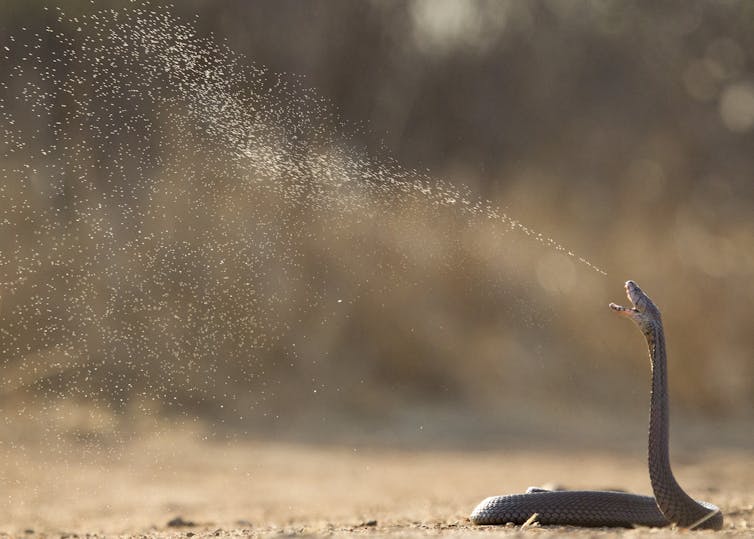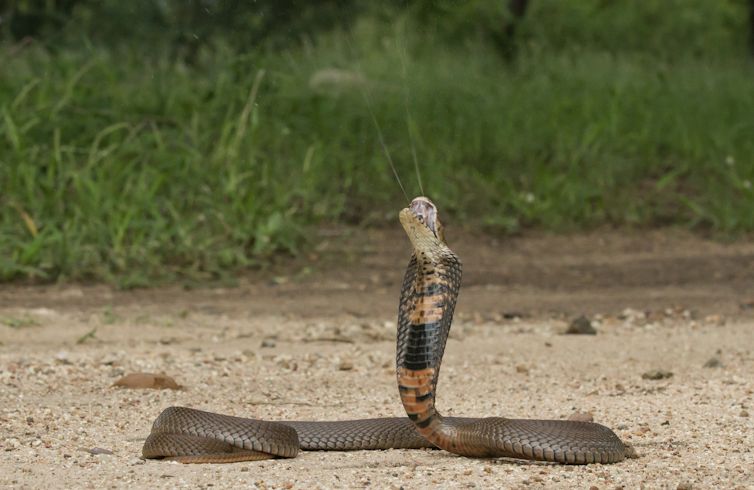
Taline Kazandjian, Liverpool School of Tropical Medicine; Harry Greene, Cornell University; Nicholas Casewell, Liverpool School of Tropical Medicine, and Wolfgang Wüster, Bangor University
Cobras are fascinating and frightening creatures. These snakes are most well known for their characteristic defence mechanism called hooding, when the sides of their neck flare out in a dramatic display.
However, hooding isn’t the only defensive behaviour in a cobra’s arsenal. Some species of cobra have modified fangs with small, front facing orifices. These allow them to forcibly eject venom as a spray or “spit”, which can hit the eyes of a target up to 2.5 metres away. For this behaviour, they are known as spitting cobras.
Bizarrely, this unique adaptation has evolved three times independently in a small group of Afro-Asian snakes: once in African cobras, once in Asian cobras, and once in the related rinkhals, also known as the ring-necked spitting cobra.
While most snakes use venom for preying on other animals, spitting cobras use it purely for defence. In a new study, we tested the venom of spitting cobras to see what toxins could be found, to work out what might have caused this defensive behaviour to evolve. The results show it might have been to ward off attacks from our human ancestors.

Unique toxin cocktails
Snake venoms are complex mixtures of proteins, used primarily in foraging to efficiently incapacitate prey. While snakes do use their venom in self defence, for example in the case of human snakebites, most of the evidence suggests venom composition has been evolved for foraging, not defence.
Venom in fixed front-fanged snakes, including cobras, tends to cause paralysis. This is due to an abundance of toxins called neurotoxic three-finger toxins, which stop neurotransmission, signals being sent from the nervous system to the prey’s muscles. However, cobras have a unique type of three-finger toxins that destroy cells, rather than block neurotransmission. These are called cytotoxins.
Our results found spitting cobras have increased the abundance of a different toxin family, called phospholipase A2 (PLA2s), in their venom compared to their non spitting counterparts. Because these cobras spit for defensive reasons, this is the first evidence of a defensive driver of venom evolution in snakes.
Toxic teamwork
Many animals that use venom defensively do so by inflicting rapid, severe pain on their aggressors. We set out to find out whether defensive spitting cobra venom would be especially painful on contact.
To assess pain causing activity, we tested cobra venom on isolated mouse neurons, responsible for sensations in the eyes and face. We suspected spitting cobra PLA2s might activate these neurons and potentially cause pain.
To our surprise, PLA2s were ineffective on their own. It was the cytotoxins, the toxins widespread in spitting and non-spitting cobras alike, that caused activation of the neurons. However, the mixture of PLA2s and cytotoxins caused this activity to increase dramatically.
This suggests spitting cobras increased the abundance of PLA2s in their venom over time, to make the already present cytotoxins much more effective as a pain inducer. The threefold independent evolution of spitting was accompanied on each occasion by the same complex, synergistic changes in venom composition.
Could human ancestors have prompted this evolution?
Venom spitting is a unique behaviour found only in a small handful of closely related snake species. Yet this projectile defence system, and the specific mixture of toxins that cause more pain, evolved three times independently, only within this small group.
This kind of defence must have been stimulated by a very strong selective pressure. We believe several factors make human ancestors the most likely selective agent.
Many primates will pre-emptively kill a snake if they feel threatened, often using projectile weapons or tools, like rocks and sticks. While these may not always be lethal, they can cause severe damage. Bipedal hominins, human ancestors who walked on two legs with forelimbs freed, almost certainly posed an even greater long-distance threat compared to their four-legged relatives. This requires a long distance defence from their serpentine enemies, like spitting.
The timing of the evolution of venom spitting coincides with key dates in the evolution of early human ancestors. The emergence of spitting in African cobras occurred at around the same time as the separation of hominins from the chimpanzees and bonobos lineage, approximately 7 million years ago. The evolution of spitting in Asian cobras occurred alongside the arrival of Homo erectus in Asia around 2.5 million years ago.
Read more: Why do snakes produce venom? Not for self-defence, study shows
In addition, fossils of spitting cobra fangs have been found in ancient hominin sites such as the cradle of humanity in Africa. Current evidence is circumstantial, which means we require more proof. However, venom spitting as a response to trampling by herd animals or being preyed on by birds or mammals is far less supported.
Additional fossils might support or refute our hypothesis. In particular, finding the fossilised remains of spitting cobras that predate the divergence between hominins and chimpanzees would refute our hypothesis.
If our distant ancestors’ tendency to attack snakes with rocks or sticks did trigger the evolution of a specific defensive adaptation in snakes, one that persists to this day, we should ponder our own place in Earth history. Rather than being a lineage apart, our human ancestors might have had a direct impact on how these animals evolved.
Taline Kazandjian, Postdoctoral Research Assistant, Liverpool School of Tropical Medicine; Harry Greene, Professor of Ecology and Evolutionary Biology , Cornell University; Nicholas Casewell, Director of Centre for Snakebite Research & Interventions, Liverpool School of Tropical Medicine, and Wolfgang Wüster, Reader in Zoology, Bangor University
This article is republished from The Conversation under a Creative Commons license. Read the original article.

